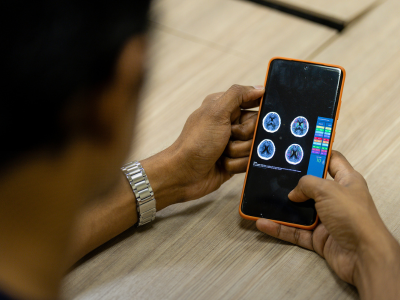Published on 20 April 2023
Using optoacoustic imaging technology, surgeons will be able to determine if there is an incomplete removal of cancer cells during an operation.
Breast cancer is among the highest occurring cancers in Singapore – according to the Singapore Cancer Registry, more than 12,000 women were newly diagnosed with the disease over a five-year period between 2016 and 2020.
While breast conserving surgeries are often performed to remove and treat early-stage cancers, about 15% of these patients will have to undergo another operation, due to the incomplete removal of the cancerous cells the first time around.
However, a recent study conducted by a team of researchers and clinicians at A*STAR’s Institute of Bioengineering and Bioimaging (IBB) and the National University Hospital (NUH) has found that the use of optoacoustic imaging could help to achieve the complete removal of cancerous breast lesions.
Optoacoustic imaging - a hybrid technology using both laser and ultrasound imaging - allows surgeons to determine an incomplete tumour excision by providing a critical layer of information. It is used to complement the current methods of verifying tumour excision – such as X-rays or ultrasound – which do not detect subtle or tiny cancer cells that could indicate incomplete excision of cancer.
The study, which was done with patients recruited through the National University Cancer Institute, Singapore (NCIS), showed that the method of optoacoustic imaging had a diagnostic accuracy of up to 99%.
The Principal Investigator of the study, Dr Goh Yong Geng, a Consultant at the Department of Diagnostic Imaging in NUH, said, “Based on our first-in-human study, we have determined that the diagnostic accuracy of this method is about 95% to 99%. This is a very promising imaging technology that can improve the efficacy of breast cancer surgeries.
“We will continue to leverage this technology for further advancement in improving the efficiency and effectiveness of breast cancer treatment to help save on costs and time for patients and hospital resources.”
In breasts, collagen is one of the major structural components of the tissue architecture, and also an important component of the cancer microenvironment.
The study showed that optoacoustic imaging can not only image fat and blood of varying oxygenation status, but also the distribution of collagen in breast tissue, allowing for greater accuracy in assessing the success of the surgery.
Dr Gayathri Balasundaram, Research Scientist at A*STAR’s IBB said, “We worked together with breast radiologists and surgeons from NUH to demonstrate proof of concept of photoacoustic imaging to assess the success of breast cancer surgery.
“These findings could help in further development of an accurate surgical margin assessment tool that can provide intraoperative feedback, which would enhance the success of breast surgery. This could help to reduce reoperation and prevent further psychological stress for patients.”
Prof Malini Olivo, Senior Principal Investigator at A*STAR’s IBB, added, “The novel photoacoustic ultrasound hybrid imaging technology developed at IBB’s Translational Biophotonics lab could be game changing in identifying both structural and intrinsic biomarkers that determine cancer margins during breast cancer surgery.”
The team plans to conduct further research using this method of imaging through larger studies in the future.
In consultation with Dr Goh Yong Geng, Consultant, Department of Diagnostic Imaging, NUH


